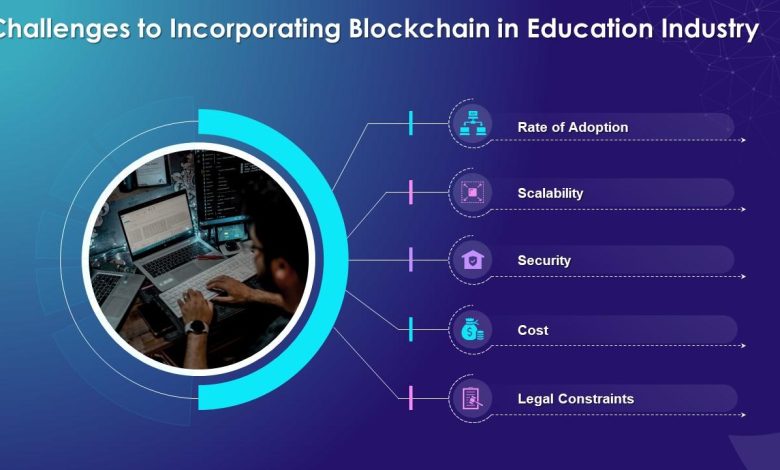Exploring the Potential of Blockchain in Education

- Understanding the basics of blockchain technology
- Benefits of implementing blockchain in educational institutions
- Challenges and limitations of using blockchain in education
- Case studies of successful blockchain integration in the education sector
- Exploring the role of smart contracts in revolutionizing education
- Future possibilities and trends of blockchain technology in the education industry
Understanding the basics of blockchain technology
Blockchain technology is a decentralized, distributed ledger system that securely records transactions across a network of computers. Each transaction is stored in a “block” that is linked to the previous block, forming a chain of blocks – hence the name “blockchain.” This technology ensures transparency, security, and immutability of data, making it an ideal solution for various industries, including education.
In the context of education, blockchain technology can revolutionize the way academic credentials are verified and stored. By using blockchain, educational institutions can create a tamper-proof system for issuing and verifying degrees, certificates, and diplomas. This eliminates the need for third-party verification and reduces the risk of fraud.
Moreover, blockchain can facilitate the transfer of credits between institutions, making it easier for students to switch schools or pursue further education. With blockchain, students can have a digital wallet containing all their academic records, which they can share with potential employers or other educational institutions.
Another potential application of blockchain in education is in the realm of e-learning. By using blockchain technology, online learning platforms can create a secure and transparent system for tracking student progress, issuing certificates of completion, and even facilitating peer-to-peer payments between students and instructors.
Overall, understanding the basics of blockchain technology is crucial for educators, administrators, and policymakers looking to harness its potential in the field of education. By leveraging blockchain technology, educational institutions can streamline administrative processes, enhance data security, and ultimately provide a more efficient and trustworthy learning experience for students.
Benefits of implementing blockchain in educational institutions
Implementing blockchain technology in educational institutions can bring about a multitude of benefits that can revolutionize the way data is managed and shared. Some of the key advantages of integrating blockchain in the education sector include:
- **Enhanced Security:** One of the most significant advantages of blockchain technology is its high level of security. By utilizing cryptographic algorithms and decentralized storage, blockchain can ensure that student records, certificates, and other sensitive information are protected from tampering and unauthorized access.
- **Transparency and Trust:** Blockchain creates a transparent and immutable record of transactions, making it easier for educational institutions to verify the authenticity of academic credentials and certifications. This can help combat issues such as diploma mills and fake degrees.
- **Streamlined Processes:** By leveraging blockchain for tasks such as student enrollment, course registration, and credential verification, educational institutions can streamline administrative processes and reduce paperwork. This can lead to cost savings and increased efficiency.
- **Credential Portability:** With blockchain, students can have ownership of their academic records and credentials, allowing them to securely share this information with potential employers or other educational institutions. This can facilitate seamless transitions between different stages of education and employment.
- **Reduced Fraud:** Blockchain’s decentralized nature and consensus mechanisms make it extremely difficult for fraudulent activities to occur. This can help prevent issues such as identity theft, credential fraud, and academic dishonesty.
Overall, the implementation of blockchain technology in educational institutions has the potential to transform the way data is managed, shared, and verified. By harnessing the power of blockchain, educational institutions can enhance security, improve transparency, streamline processes, enable credential portability, and reduce fraud. This can ultimately lead to a more efficient, trustworthy, and secure educational ecosystem.
Challenges and limitations of using blockchain in education
When considering the implementation of blockchain technology in education, it is essential to acknowledge the challenges and limitations that may arise. While blockchain offers numerous benefits such as increased security, transparency, and efficiency, there are also several obstacles that need to be addressed.
- One of the main challenges of using blockchain in education is the issue of scalability. As the number of transactions and data stored on the blockchain increases, so does the size of the blockchain. This can lead to slower transaction times and higher costs, making it difficult to scale the technology for widespread use in educational institutions.
- Another limitation is the lack of standardization and interoperability among different blockchain platforms. This can make it challenging for educational organizations to adopt blockchain technology, as they may need to invest in multiple platforms or develop custom solutions to ensure compatibility.
- Additionally, there are concerns about data privacy and security when using blockchain in education. While blockchain is known for its secure and immutable nature, there is still a risk of data breaches and unauthorized access if proper security measures are not in place.
- Moreover, the complexity of blockchain technology can be a barrier to adoption in education. Many educators and administrators may not have the technical expertise required to implement and manage blockchain systems effectively, leading to resistance and reluctance to embrace the technology.
- Lastly, regulatory challenges and legal considerations can also hinder the widespread use of blockchain in education. There may be concerns about compliance with data protection laws, intellectual property rights, and other regulations that could impact the implementation of blockchain solutions in educational settings.
In conclusion, while blockchain has the potential to revolutionize the education sector, it is essential to address these challenges and limitations to ensure successful implementation and adoption. By overcoming these obstacles through collaboration, innovation, and strategic planning, educational institutions can harness the power of blockchain to enhance learning experiences and improve administrative processes.
Case studies of successful blockchain integration in the education sector
Several case studies have demonstrated the successful integration of blockchain technology in the education sector, showcasing its potential to revolutionize various processes. These examples highlight the benefits of blockchain in enhancing security, transparency, and efficiency in educational institutions.
- One notable case study involves the implementation of blockchain for academic credential verification. By storing credentials on a decentralized ledger, institutions can prevent fraud and ensure the authenticity of qualifications.
- Another successful application of blockchain in education is the creation of tamper-proof student records. Through blockchain, students can securely access and share their academic achievements with potential employers or other institutions.
- Blockchain has also been utilized to streamline administrative tasks such as course registration and fee payments. By automating these processes through smart contracts, institutions can reduce paperwork and eliminate errors.
Furthermore, blockchain technology has been leveraged to create decentralized learning platforms that offer personalized educational experiences. These platforms use blockchain to track student progress, recommend tailored learning materials, and facilitate peer-to-peer collaboration.
In conclusion, the case studies of successful blockchain integration in the education sector demonstrate the transformative potential of this technology. By leveraging blockchain, educational institutions can enhance data security, improve operational efficiency, and provide innovative learning solutions to students.
Exploring the role of smart contracts in revolutionizing education
Smart contracts have the potential to revolutionize the field of education by streamlining administrative processes, enhancing security, and increasing transparency. These self-executing contracts are stored on a blockchain, ensuring that all parties involved in an agreement adhere to the terms without the need for intermediaries. By automating tasks such as verifying credentials, processing payments, and managing student records, smart contracts can save time and reduce the risk of human error.
One of the key benefits of smart contracts in education is their ability to create a tamper-proof record of academic achievements. This can help prevent fraud and ensure that qualifications are legitimate. Additionally, smart contracts can enable the creation of decentralized autonomous organizations (DAOs) that allow for more democratic decision-making processes within educational institutions.
Furthermore, smart contracts can facilitate the creation of personalized learning pathways for students by tracking their progress and adjusting coursework accordingly. This can help educators tailor their teaching methods to meet the individual needs of each student, ultimately leading to better learning outcomes. By leveraging the power of blockchain technology, education can become more efficient, secure, and student-centered.
Future possibilities and trends of blockchain technology in the education industry
Blockchain technology has the potential to revolutionize the education industry by providing a secure and transparent way to store and verify academic credentials. As the demand for online learning continues to grow, blockchain can play a crucial role in ensuring the integrity of digital certificates and diplomas. By using blockchain, educational institutions can create a tamper-proof record of student achievements that is easily accessible and verifiable by employers and other institutions.
One of the key benefits of blockchain in education is the ability to streamline the credential verification process. Instead of relying on traditional methods that can be time-consuming and prone to errors, blockchain allows for instant verification of credentials, saving time and reducing the risk of fraud. This can be especially useful for employers who need to quickly verify the qualifications of job candidates.
Another trend in blockchain technology is the use of smart contracts to automate various processes in education, such as student enrollment, course registration, and payment processing. Smart contracts are self-executing contracts with the terms of the agreement directly written into code. By using smart contracts, educational institutions can reduce administrative costs and improve efficiency.
Looking ahead, blockchain technology has the potential to create a decentralized education ecosystem where students have more control over their own learning records and can easily share them with other institutions or potential employers. This could lead to a more personalized and flexible approach to education, where students can access a wider range of courses and credentials from different providers.



